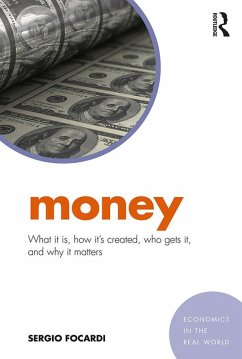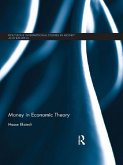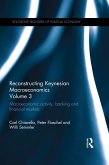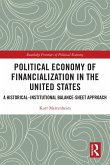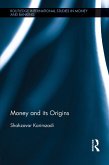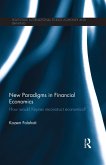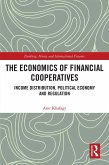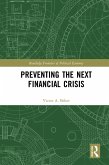40,95 €
40,95 €
inkl. MwSt.
Sofort per Download lieferbar

20 °P sammeln
40,95 €
Als Download kaufen

40,95 €
inkl. MwSt.
Sofort per Download lieferbar

20 °P sammeln
Jetzt verschenken
Alle Infos zum eBook verschenken
40,95 €
inkl. MwSt.
Sofort per Download lieferbar
Alle Infos zum eBook verschenken

20 °P sammeln
- Format: PDF
- Merkliste
- Auf die Merkliste
- Bewerten Bewerten
- Teilen
- Produkt teilen
- Produkterinnerung
- Produkterinnerung

Bitte loggen Sie sich zunächst in Ihr Kundenkonto ein oder registrieren Sie sich bei
bücher.de, um das eBook-Abo tolino select nutzen zu können.
Hier können Sie sich einloggen
Hier können Sie sich einloggen
Sie sind bereits eingeloggt. Klicken Sie auf 2. tolino select Abo, um fortzufahren.

Bitte loggen Sie sich zunächst in Ihr Kundenkonto ein oder registrieren Sie sich bei bücher.de, um das eBook-Abo tolino select nutzen zu können.
Understanding money - its creation, distribution and the value attached to it- is critical to understanding a society. This book introduces the principal theories of money, integrating them with macroeconomics and addressing key questions. What is money? How is it generated? How is it distributed? How does money impact the economy and society?
- Geräte: PC
- mit Kopierschutz
- eBook Hilfe
- Größe: 2.14MB
Andere Kunden interessierten sich auch für
![Money in Economic Theory (eBook, PDF) Money in Economic Theory (eBook, PDF)]() Hasse EkstedtMoney in Economic Theory (eBook, PDF)59,95 €
Hasse EkstedtMoney in Economic Theory (eBook, PDF)59,95 €![Reconstructing Keynesian Macroeconomics Volume 3 (eBook, PDF) Reconstructing Keynesian Macroeconomics Volume 3 (eBook, PDF)]() Carl ChiarellaReconstructing Keynesian Macroeconomics Volume 3 (eBook, PDF)44,95 €
Carl ChiarellaReconstructing Keynesian Macroeconomics Volume 3 (eBook, PDF)44,95 €![Political Economy of Financialization in the United States (eBook, PDF) Political Economy of Financialization in the United States (eBook, PDF)]() Kurt MettenheimPolitical Economy of Financialization in the United States (eBook, PDF)42,95 €
Kurt MettenheimPolitical Economy of Financialization in the United States (eBook, PDF)42,95 €![Money and its Origins (eBook, PDF) Money and its Origins (eBook, PDF)]() Shahzavar KarimzadiMoney and its Origins (eBook, PDF)48,95 €
Shahzavar KarimzadiMoney and its Origins (eBook, PDF)48,95 €![New Paradigms in Financial Economics (eBook, PDF) New Paradigms in Financial Economics (eBook, PDF)]() Kazem FalahatiNew Paradigms in Financial Economics (eBook, PDF)48,95 €
Kazem FalahatiNew Paradigms in Financial Economics (eBook, PDF)48,95 €![The Economics of Financial Cooperatives (eBook, PDF) The Economics of Financial Cooperatives (eBook, PDF)]() Amr KhafagyThe Economics of Financial Cooperatives (eBook, PDF)44,95 €
Amr KhafagyThe Economics of Financial Cooperatives (eBook, PDF)44,95 €![Preventing the Next Financial Crisis (eBook, PDF) Preventing the Next Financial Crisis (eBook, PDF)]() Victor A. BekerPreventing the Next Financial Crisis (eBook, PDF)40,95 €
Victor A. BekerPreventing the Next Financial Crisis (eBook, PDF)40,95 €-
-
-
Understanding money - its creation, distribution and the value attached to it- is critical to understanding a society. This book introduces the principal theories of money, integrating them with macroeconomics and addressing key questions. What is money? How is it generated? How is it distributed? How does money impact the economy and society?
Dieser Download kann aus rechtlichen Gründen nur mit Rechnungsadresse in A, B, BG, CY, CZ, D, DK, EW, E, FIN, F, GR, HR, H, IRL, I, LT, L, LR, M, NL, PL, P, R, S, SLO, SK ausgeliefert werden.
Produktdetails
- Produktdetails
- Verlag: Taylor & Francis eBooks
- Seitenzahl: 202
- Erscheinungstermin: 19. März 2018
- Englisch
- ISBN-13: 9781315391052
- Artikelnr.: 53238840
- Verlag: Taylor & Francis eBooks
- Seitenzahl: 202
- Erscheinungstermin: 19. März 2018
- Englisch
- ISBN-13: 9781315391052
- Artikelnr.: 53238840
- Herstellerkennzeichnung Die Herstellerinformationen sind derzeit nicht verfügbar.
Sergio M. Focardi is Professor of Finance and researcher at the Léonard de Vinci Pôle Universitaire, Paris-La Defense, France. He is a member of the editorial board of the Journal of Portfolio Management and has authored numerous articles and books on mathematical finance, including a series of monographs for the CFA Institute Research Foundation, including the recent Equity Valuation: Science, Art, or Craft?
Introductory remarks
1. The Theory of Money: Basic Concepts
Part I
1.1 Introduction 1.2 Can We Do Without Money?
1.3 Money
Markets
and Value
2. The Theory of Money: Basic Concepts Part II
2.1 Do We Need a Theory of Money?
2.2 Operationalism and Theories of Money
2.3 The Concept of Stock-flow Consistency
2.4 Money and Macroeconomics
2.5 A Framework for Understanding Theories of Money
3. What Is Money?
3.1 Some Brief Remarks on Money Throughout History
3.2 Alternative Forms of Money
3.3 So Just What Is Money? Metallists and Chartalists
4. Modelling Money
4.1 Modelling Coins
4.2 Modelling Fiat Money
5. How Money Is Created
5.1 The Question of Money Generation
5.2 Creating Traditional Forms of Money
5.3 The Creation of Bank Deposits and the Multiplier
5.4 The Creation of Bank Deposits and Endogenous Money Generation
5.5 Nonconventional Ways Central Banks Can Create Money
5.6 Other Ways to Create Money
6. How Money Acquires Value and How that Value Changes over Time
6.1 How Money Gains Acceptance
6.2 How Money Acquires Value
6.3 How the Value of Money Changes: The Elusive Concept of Inflation
6.4 Chartalism and the State Theory of Money
7. Money: How It's Distributed
7.1 The Question of the Distribution of Money
7.2 Who Gets the (New) Money?
7.3 Persuading the Sceptics: Loans and Bank Deposits
7.4 Closing Considerations on the Role of Commercial Banks in Allocating Money
8. Money and the Economy
8.1 Money and Classical Economic Theory
8.2 The Theory of the Circuit of Money
8.3 Puzzles: The Declining Velocity of Money and Missing Inflation
8.4 Money and Complexity
8.5 Economic and Financial Instabilities
8.6 Modern Money Theory
8.7 Stock-flow Consistent Models
Concluding remarks
Index
1. The Theory of Money: Basic Concepts
Part I
1.1 Introduction 1.2 Can We Do Without Money?
1.3 Money
Markets
and Value
2. The Theory of Money: Basic Concepts Part II
2.1 Do We Need a Theory of Money?
2.2 Operationalism and Theories of Money
2.3 The Concept of Stock-flow Consistency
2.4 Money and Macroeconomics
2.5 A Framework for Understanding Theories of Money
3. What Is Money?
3.1 Some Brief Remarks on Money Throughout History
3.2 Alternative Forms of Money
3.3 So Just What Is Money? Metallists and Chartalists
4. Modelling Money
4.1 Modelling Coins
4.2 Modelling Fiat Money
5. How Money Is Created
5.1 The Question of Money Generation
5.2 Creating Traditional Forms of Money
5.3 The Creation of Bank Deposits and the Multiplier
5.4 The Creation of Bank Deposits and Endogenous Money Generation
5.5 Nonconventional Ways Central Banks Can Create Money
5.6 Other Ways to Create Money
6. How Money Acquires Value and How that Value Changes over Time
6.1 How Money Gains Acceptance
6.2 How Money Acquires Value
6.3 How the Value of Money Changes: The Elusive Concept of Inflation
6.4 Chartalism and the State Theory of Money
7. Money: How It's Distributed
7.1 The Question of the Distribution of Money
7.2 Who Gets the (New) Money?
7.3 Persuading the Sceptics: Loans and Bank Deposits
7.4 Closing Considerations on the Role of Commercial Banks in Allocating Money
8. Money and the Economy
8.1 Money and Classical Economic Theory
8.2 The Theory of the Circuit of Money
8.3 Puzzles: The Declining Velocity of Money and Missing Inflation
8.4 Money and Complexity
8.5 Economic and Financial Instabilities
8.6 Modern Money Theory
8.7 Stock-flow Consistent Models
Concluding remarks
Index
Introductory remarks
1. The Theory of Money: Basic Concepts
Part I
1.1 Introduction 1.2 Can We Do Without Money?
1.3 Money
Markets
and Value
2. The Theory of Money: Basic Concepts Part II
2.1 Do We Need a Theory of Money?
2.2 Operationalism and Theories of Money
2.3 The Concept of Stock-flow Consistency
2.4 Money and Macroeconomics
2.5 A Framework for Understanding Theories of Money
3. What Is Money?
3.1 Some Brief Remarks on Money Throughout History
3.2 Alternative Forms of Money
3.3 So Just What Is Money? Metallists and Chartalists
4. Modelling Money
4.1 Modelling Coins
4.2 Modelling Fiat Money
5. How Money Is Created
5.1 The Question of Money Generation
5.2 Creating Traditional Forms of Money
5.3 The Creation of Bank Deposits and the Multiplier
5.4 The Creation of Bank Deposits and Endogenous Money Generation
5.5 Nonconventional Ways Central Banks Can Create Money
5.6 Other Ways to Create Money
6. How Money Acquires Value and How that Value Changes over Time
6.1 How Money Gains Acceptance
6.2 How Money Acquires Value
6.3 How the Value of Money Changes: The Elusive Concept of Inflation
6.4 Chartalism and the State Theory of Money
7. Money: How It's Distributed
7.1 The Question of the Distribution of Money
7.2 Who Gets the (New) Money?
7.3 Persuading the Sceptics: Loans and Bank Deposits
7.4 Closing Considerations on the Role of Commercial Banks in Allocating Money
8. Money and the Economy
8.1 Money and Classical Economic Theory
8.2 The Theory of the Circuit of Money
8.3 Puzzles: The Declining Velocity of Money and Missing Inflation
8.4 Money and Complexity
8.5 Economic and Financial Instabilities
8.6 Modern Money Theory
8.7 Stock-flow Consistent Models
Concluding remarks
Index
1. The Theory of Money: Basic Concepts
Part I
1.1 Introduction 1.2 Can We Do Without Money?
1.3 Money
Markets
and Value
2. The Theory of Money: Basic Concepts Part II
2.1 Do We Need a Theory of Money?
2.2 Operationalism and Theories of Money
2.3 The Concept of Stock-flow Consistency
2.4 Money and Macroeconomics
2.5 A Framework for Understanding Theories of Money
3. What Is Money?
3.1 Some Brief Remarks on Money Throughout History
3.2 Alternative Forms of Money
3.3 So Just What Is Money? Metallists and Chartalists
4. Modelling Money
4.1 Modelling Coins
4.2 Modelling Fiat Money
5. How Money Is Created
5.1 The Question of Money Generation
5.2 Creating Traditional Forms of Money
5.3 The Creation of Bank Deposits and the Multiplier
5.4 The Creation of Bank Deposits and Endogenous Money Generation
5.5 Nonconventional Ways Central Banks Can Create Money
5.6 Other Ways to Create Money
6. How Money Acquires Value and How that Value Changes over Time
6.1 How Money Gains Acceptance
6.2 How Money Acquires Value
6.3 How the Value of Money Changes: The Elusive Concept of Inflation
6.4 Chartalism and the State Theory of Money
7. Money: How It's Distributed
7.1 The Question of the Distribution of Money
7.2 Who Gets the (New) Money?
7.3 Persuading the Sceptics: Loans and Bank Deposits
7.4 Closing Considerations on the Role of Commercial Banks in Allocating Money
8. Money and the Economy
8.1 Money and Classical Economic Theory
8.2 The Theory of the Circuit of Money
8.3 Puzzles: The Declining Velocity of Money and Missing Inflation
8.4 Money and Complexity
8.5 Economic and Financial Instabilities
8.6 Modern Money Theory
8.7 Stock-flow Consistent Models
Concluding remarks
Index
